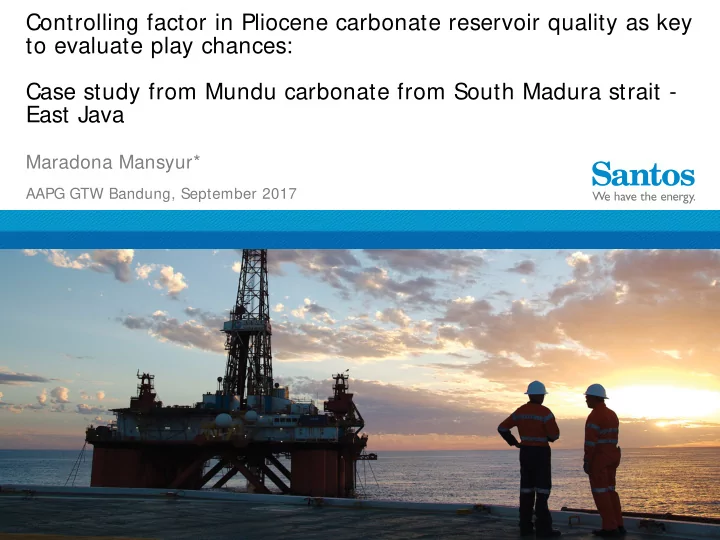

Controlling factor in Pliocene carbonate reservoir quality as key to evaluate play chances: Case study from Mundu carbonate from South Madura strait - East Java Maradona Mansyur* AAPG GTW Bandung, September 2017
Today’s Agenda • Studied area • Mundu play in East Java • Data, observation, and result • Comparison to Miocene carbonate from East java • Factors controlling reservoir porosity and Permeability • Conclusions and recommendation
• Surface geology map combined with isopach of Studied area tertiary sediment • East – West trend of low and high Map edited from: Smyth, 2008; Waltham, 2008
Studied area • North – South seismic transects from the studied area
Studied area • Simplified wheeler reconstruction diagram • Definition of Randublatung low and Kendeng
• Definition of Mundu Studied area • Discussed interval, limitation and assumption Bali/Lombok Madura Discussed interval
• Documented Mundu discoveries Mundu play • Cumulative > 3.2 Trillion cubic feet discovered gas • TER commercial discovery made on 1983 followed by MD and SIRA • Drilled on 2D seismic • Aggressive exploration post 2001 after 3D seismic technology application
• Mundu consist of > 85% foraminifera bioclasts Data, observation, and result • Previously said to be pelagic rain deposit and product of contourite • Compilation of sedimentary structure found wave-tidal hydrodynamic association • Collection of bioturbation indicating shore-shelf likelihood • Multi-grains composition: swamp pollen/paly, lagoonal benthic forams, deepwater buliminids, encrusted coral and algae grains 8 | SANTOS 2017
Data, observation, Field close to Madura and result • Excellent reservoir consist of granules clast with sand-silt 1 mm carbonate matrix • Very-good reservoir composed of granules- coarse sand grain with silt carbonate matrix 1 mm • Less quality reservoir made by finer grain Field close to shelf-slope break sand grain with silt carbonate matrix, cemented 9 | SANTOS 2017 1 mm
Data, observation, and result • Macro –meso and micro pore connection supporting the permeability • Enabled due to the intraparticle- interparticle porosity connection through foraminifera test open punctae • Clogged punctae associated with cement development and clay appearances
• Compiled porosity versus permeability data from 12 Data, observation, field producing from Mundu and result • Total 1008 core plug data and 257 thin section slides The best Mundu limestone reservoir belong to coarse grainstone, with minor cementation, minor clay minerals, and less bioturbated
• Stable isotopes plot modern day foraminifera vs Data, observation, ancient carbonate and result • Modern day data indicate tropical seawater • Contrast Carbon- Oxygen isotopes signature • Modern day data indicate carbonate grains not yet through diagenesis process • Ancient carbonate from Kujung indicate an extensively karstified carbonate grains Modern day foram data from: Mahyar Mohtadi et.al., 2008 Ancient carbonate data from: Dicky Hehakaya, 2017
Mundu Vs. • Stable isotopes from Mundu occupy the same field with modern day foraminifera from Indonesia water Oligocene/Miocene Carbonate • Variation on oxygen indicate water temperature • Mundu Carbon-Oxygen isotopes indicate no/minor diagenesis takes place at the reservoir zone. • Diagenesis shutdown due to no diagenesis cross-fluid exchange during burial. • Indicating very early hydrocarbon filling to reservoir . Modern day foram data from: Mahyar Mohtadi et.al., 2008 Ancient carbonate data from: Dicky Hehakaya, 2017 Data from this study from: OY ( R.Tampubolon, 2016) & ME field
A A’ Depositional mechanism Depositional setup during deposition • East-West 3D seismic transect from studied area controlled with borehole biostratigraphy • Mundu deposited during an extensive transgressive time • Deposition from time to time always associated with shelf-slope topography
• Internal wave from Bali – Lombok strait Depositional setup during deposition • Occur due to densely stratified water flowing through rough and shallow barier • Internal waves occur SAR image Echogram image within subsurface layer of ocean with dense stratification • Disturbance occur when the dense water flow passing over shallow underwater obstacles such; sill Susanto, Mitnik & Zhang, 2005 (guyot) or shallow ridge • The disturbance causing body of water with shore wave and tidal attitude Observed internal wave locality from Java to Flores
Depositional model: process and product Mixed layer interval • Internal waves flow hit the shelf break and Deeper water interval depositing the high density plankton in water. • Tide and waves generated by the interlayer disturbance winnowed the deposited sediment. • Disturbance also generate canyon/buttress zone, where the un-winnowed sediment flow following gravity differences (canyon-subsea channel features
Conclusion and recommendation • Mundu reservoir quality is strongly controlled by the sorting process and the diagenesis shutdown • New term : Internalites deposit differ from conventional contourites • New exploration paradigm where unexplored area waiting for new 3D seismic and further exploration drilling aiming at internalites deposit off-shore Bali Flores Observed internal wave locality from Java to Flores
Acknowledgement • Santos (Sampang) Pty.Ltd, colleagues, and managements • Prof. John Keith Warren, Ricky Tampubolon, and Dicky Hehakaya from Chulalongkorn University • Prof. Ian Cartwright from Monash University
THANK YOU
Recommend
More recommend